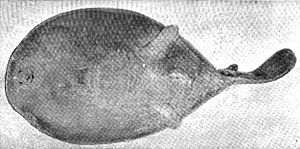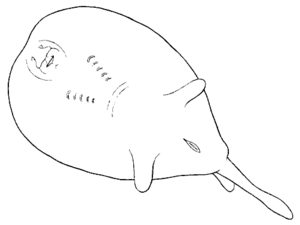Oval electric ray facts for kids
Quick facts for kids Oval electric ray |
|
|---|---|
 |
|
| Conservation status | |
| Scientific classification |
The oval electric ray (Typhlonarke aysoni) is a special type of sleeper ray. It belongs to the Narkidae family. This ray is found only in New Zealand. It usually lives on the sea floor about 300 to 400 meters (980–1,310 feet) deep.
This ray is quite small, usually less than 30 centimeters (12 inches) long. It has a thick, oval body shape. Its tail is short and strong, with one dorsal fin on top. The oval electric ray is blind because its tiny eyes are covered by skin. Its pelvic fins are split into two parts. The front part looks like a small leg. These leg-like fins might help the ray "walk" along the ocean bottom. This is because it probably cannot swim very well.
Adult male rays have special parts called claspers that stick out past their body. The ray eats polychaete worms. It gives birth to live young, but they don't get food from a placenta. This ray can also create an electric shock to protect itself. Scientists don't have enough information yet to know how many of these rays are left.
Contents
Discovering the Oval Electric Ray
How it Got its Name
The oval electric ray was first described by William John Phillipps. He worked at the Dominion Museum in New Zealand. He wrote about it in a science journal in 1929. The first ray studied was found near Island Bay, Wellington.
Another scientist, Augustus Hamilton, had drawn a picture of this ray earlier in 1909. He was describing a similar ray called the blind electric ray (T. aysoni). Hamilton found his ray at a fish market in Dunedin. He noticed it looked different, but he didn't realize it was a new species. Sometimes, the oval electric ray is also called the blind electric ray.
Where it Lives and Its Home
Finding the Ray's Home
It can be tricky to know exactly where the oval electric ray lives. This is because it is often confused with the blind electric ray. Both types of Typhlonarke rays live off the eastern coast of New Zealand. You can find them from the East Cape of North Island down to the Snares Shelf. This area includes the Cook and Foveaux Straits. They also live near Stewart and Chatham Islands.
Deep-Sea Dweller
This ray lives on the bottom of the ocean. It is usually found at depths of 300 to 400 meters (980–1,310 feet). But some have been seen as shallow as 46 meters (151 feet). Others have been found as deep as 800 meters (2,600 feet).
What the Oval Electric Ray Looks Like
The body of the oval electric ray is shaped like an oval. It gets narrower smoothly towards the back. The edges of its body are very thick. Its eyes are tiny, about 2–3 millimeters (0.08–0.12 inches) under the skin. You can't see them from the outside. But small white spots show where they are.
Breathing and Eating Parts
Behind the eyes are oval-shaped openings called spiracles. They have smooth edges. The nostrils are close together. Their outer edges curl up like tubes. Their inner edges are wide and joined together. They form a fleshy curtain that almost hides the small mouth. The ray has 11 rows of teeth in each jaw. These teeth form narrow plates at the front of the mouth. The teeth at the back are sharp. The ones at the front are blunt from use. It has five pairs of short, curved gill slits. The first and fifth pairs are smaller than the others.
Special Fins and Body Color
Each pelvic fin is split into two parts. The front part is a long, finger-like limb. The back part blends smoothly with the main body. The back edges of the pelvic fins join the body without a dip. Adult males have cylindrical claspers that stick out past the body. The single dorsal fin has a rounded edge. It starts just before the body meets the tail. The tail is short and thick. It has faint skin folds along its sides. The tail ends in a nearly round caudal fin. The ray's skin is completely smooth.
The oval electric ray is dark brown on top. It gets lighter towards the edges of its body and on its underside. The area around its mouth and nostrils, and the underside of its pelvic limbs, are white. This species can grow up to 36 centimeters (14 inches) long. However, most are usually less than 30 centimeters (12 inches).
Biology and Life Cycle
How it Moves and Defends Itself
The oval electric ray has a thick, soft body and a small tail. It seems like it can barely swim. Instead, it likely uses its movable pelvic fin "legs" to push itself along the ocean floor. These "legs" are more developed than those of the T. aysoni.
Like other electric rays, it can give an electric shock to defend itself. It has two kidney-shaped electric organs on each side of its head. Each organ has 180–200 large, fluid-filled hexagonal columns. These columns act like batteries connected in a parallel circuit.
What it Eats and How it Reproduces
Since it's blind, the oval electric ray catches its food by suction. It is known to eat polychaete worms. This ray gives birth to live young. Females can have up to 11 babies at a time. The newborn rays are about 9–10 centimeters (3.5–3.9 inches) long.
Human Interactions and Conservation
Fishing and Protection Status
The oval electric ray can get caught in bottom trawl nets. There is a lot of commercial fishing in the areas where it lives. This might be a concern for the species. However, the International Union for Conservation of Nature (IUCN) doesn't have enough information. So, they have listed it as "Data Deficient". This means more research is needed.
In June 2018, the New Zealand Department of Conservation said the oval electric ray is "Not Threatened." But they added the note "Data Poor." This means they don't have a lot of information about its population.



